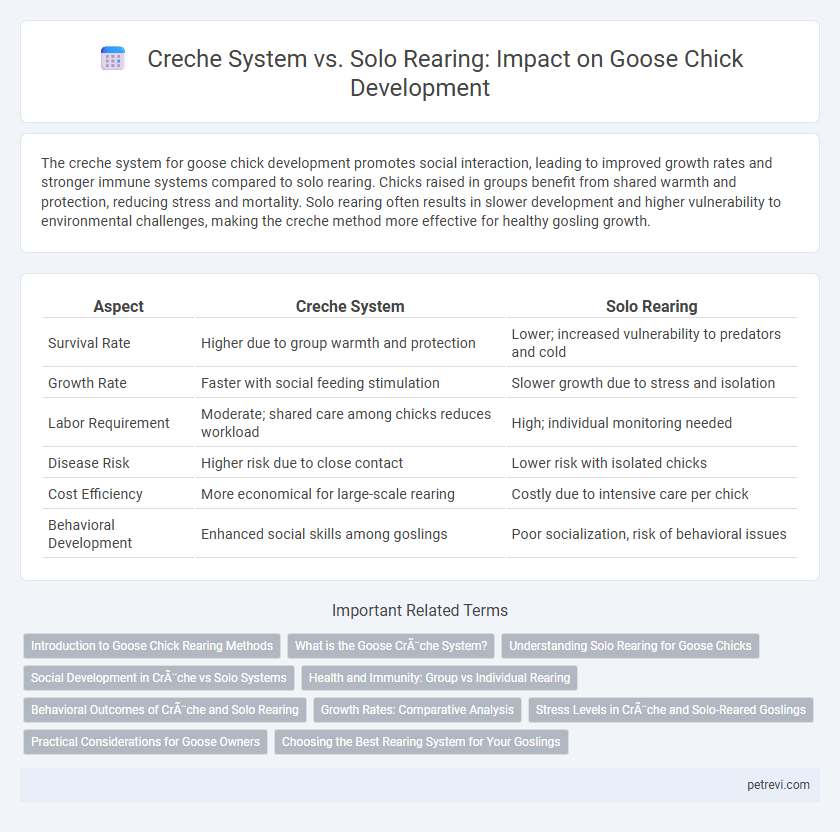The creche system for goose chick development promotes social interaction, leading to improved growth rates and stronger immune systems compared to solo rearing. Chicks raised in groups benefit from shared warmth and protection, reducing stress and mortality. Solo rearing often results in slower development and higher vulnerability to environmental challenges, making the creche method more effective for healthy gosling growth.
Table of Comparison
| Aspect | Creche System | Solo Rearing |
|---|---|---|
| Survival Rate | Higher due to group warmth and protection | Lower; increased vulnerability to predators and cold |
| Growth Rate | Faster with social feeding stimulation | Slower growth due to stress and isolation |
| Labor Requirement | Moderate; shared care among chicks reduces workload | High; individual monitoring needed |
| Disease Risk | Higher risk due to close contact | Lower risk with isolated chicks |
| Cost Efficiency | More economical for large-scale rearing | Costly due to intensive care per chick |
| Behavioral Development | Enhanced social skills among goslings | Poor socialization, risk of behavioral issues |
Introduction to Goose Chick Rearing Methods
Goose chick rearing methods primarily include the creche system and solo rearing, each impacting growth and survival rates differently. The creche system involves group brooding under a foster mother goose, enhancing social learning and warmth, which boosts chick development. Solo rearing, where chicks are raised individually or in small groups without adult supervision, demands precise environmental control but allows for tailored care to optimize early chick health and growth.
What is the Goose Crèche System?
The Goose Creche System involves grouping multiple goose chicks under the care of a surrogate mother or a dedicated caretaker, promoting social interaction and reducing stress during early development. This method enhances growth rates, improves immunity, and facilitates better behavioral development compared to solo rearing, where chicks are raised individually without peer contact. Studies in avian husbandry indicate that the creche system optimizes feed efficiency and overall chick welfare by mimicking natural brood-rearing environments.
Understanding Solo Rearing for Goose Chicks
Solo rearing for goose chicks involves raising them individually or in small groups without adult geese, which requires precise temperature control and frequent feeding to ensure proper growth and survival. This method allows for close monitoring of each chick's health and development but demands more labor and resources compared to the traditional creche system, where goslings are cared for communally under adult supervision. Understanding solo rearing is essential for optimizing chick welfare and maximizing growth rates in controlled environments.
Social Development in Crèche vs Solo Systems
Goose chicks raised in a creche system exhibit enhanced social development, including improved communication skills and group cohesion, compared to those reared solo, who may display increased stress and social withdrawal. The creche environment fosters natural behaviors like synchronized foraging and mutual grooming, crucial for emotional security and survival instincts. Solo rearing limits peer interaction, often resulting in delayed social milestones and reduced adaptability within flock dynamics.
Health and Immunity: Group vs Individual Rearing
Group rearing in creche systems enhances goose chick health and immunity by promoting natural social behaviors and facilitating microbial exposure, which strengthens immune system development. In contrast, solo rearing limits chick interaction, potentially resulting in weaker immune responses and increased susceptibility to pathogens. Studies indicate that creche-reared goslings exhibit higher survival rates and improved resistance to common diseases compared to individually reared counterparts.
Behavioral Outcomes of Crèche and Solo Rearing
Goose chicks reared in a creche system exhibit enhanced social behaviors and reduced stress levels compared to those raised solo, promoting group cohesion and natural interaction patterns. Solo rearing often results in increased fear responses and abnormal repetitive behaviors due to social isolation and lack of peer stimulation. Behavioral studies show creche-reared goslings develop stronger communication skills and adaptive coping mechanisms essential for survival in natural environments.
Growth Rates: Comparative Analysis
Goose chicks raised in a creche system demonstrate significantly higher growth rates compared to those reared solo, due to increased social interaction and shared warmth promoting better feed intake and energy conservation. Studies indicate creche-reared goslings achieve up to 15-20% faster weight gain by 8 weeks of age, enhancing overall health and survivability. Solo rearing often results in slower development and higher mortality risks due to isolation stress and inefficient thermoregulation.
Stress Levels in Crèche and Solo-Reared Goslings
Creche systems for goose chicks significantly reduce stress levels compared to solo rearing by promoting social interaction and natural behaviors essential for development. Solo-reared goslings often exhibit higher cortisol concentrations and increased anxiety-related behaviors due to isolation and lack of stimulus. Stress reduction in creche environments supports better immune function and growth rates, enhancing overall gosling welfare.
Practical Considerations for Goose Owners
Solo rearing of goose chicks requires more intensive monitoring to ensure adequate warmth, feeding, and protection from predators, making it labor-intensive for owners without specialized equipment. Creche systems provide shared heat sources and social interaction that promote natural behaviors and reduce mortality rates, especially in larger flocks. Practical considerations include space allocation, cost of heating systems, and ease of daily care, with creche systems often offering a more scalable solution for commercial or hobbyist goose keepers.
Choosing the Best Rearing System for Your Goslings
Choosing the best rearing system for goslings significantly impacts their growth and health, with creche systems promoting social interaction and natural behaviors that enhance development. Solo rearing allows for controlled environments and individualized care, reducing disease risk but possibly limiting socialization. Evaluating factors such as flock size, disease management, and resource availability helps optimize gosling survival and welfare in both systems.
Creche system vs Solo rearing for Goose chick development Infographic

 petrevi.com
petrevi.com